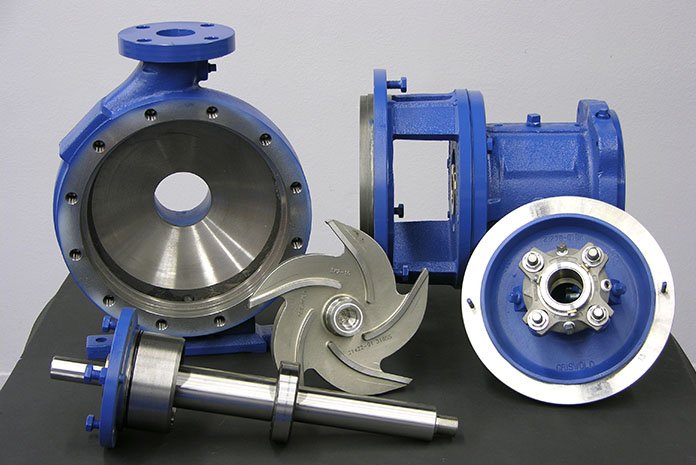By Edison Brito
Introduction
There’s no way around it: pumps play an essential role in the success of processing industries across the globe. Whether its chemical processing plants, oil fields and refineries or wastewater treatment facilities, pumps allow all these operations to function properly.
While pumps are versatile pieces of equipment, they also are not impervious to wear, which in turn impacts performance. Over time, consistent and unchecked wear can ruin a pump’s efficiency and functionality. This pathway eventually leads to failure.

While wear is inevitable with industrial equipment, it does not have to undermine a pump’s performance. The best way to keep a process pump operating at its peak throughout its lifespan is with protective and preventive maintenance. By following and maintaining a regular maintenance schedule, operators can ensure prolonged, optimal pump performance. This white paper will highlight the importance of pump maintenance while also revealing the areas to focus on for getting the most out of a process pump. For this white paper, we will focus on the maintenance concerns of centrifugal pumps.
Why Maintenance?
No matter the application or the operating conditions, a defined and routine maintenance program will extend the life of a pump. Well-maintained equipment lasts longer and requires fewer and less-expensive repairs, especially when some pumps have lifespans that extend 15 years or longer.
Regular and efficient maintenance is required to obtain optimum working life from a centrifugal pump. After purchase, the pump manufacturer typically advises the plant operator about the frequency and extent of routine maintenance. The operator, however, has the final say about how his facility’s maintenance routine will function, which could range from less frequent but more major attention to more frequent but simpler servicing. The potential cost of unexpected downtime and lost production is also a significant item when determining the total LCC of a pumping system.
The facility operator should also keep a detailed record of all preventive maintenance and repairs for each pump. This information allows operators to have an easily accessible record for diagnosing problems and eliminating, or minimizing, any future equipment downtime.
For centrifugal pumps, routine preventive and protective maintenance practices should include, at a minimum, the monitoring of:
- Bearing and lubricant condition. Monitor bearing temperatures, lubricant level and vibration. The lubricant should be clear with no signs of frothing, while changes in bearing temperature may indicate imminent failure.
- Shaft seal condition. The mechanical seals should show no signs of visible leakage. Any packing should leak at a rate of no more than 40 to 60 drops per minute.
- Overall pump vibration. Imminent bearing failure can be preceded by a change in bearing vibration. Unwanted vibration can also occur due to a change in pump alignment, the presence of cavitation or resonances between the pump, its foundation or the valving located in the suction and/or discharge lines.
- Differential pressure. The difference between the readings at the discharge and the pump’s suction will provide the total developed head pressure of the pump. A gradual decrease in the developed head pressure of the pump can indicate that the impeller clearance has widened, which requires adjustments to restore the pump’s intended design performance: impeller clearance adjustment for pumps with semi-open impeller(s) or replacement of the wear ring(s) for pumps with closed impeller(s).
Maintenance and monitoring intervals should be shortened if the pump is used in severe-service conditions, such as with highly corrosive liquids or slurries.
Quarterly Maintenance
- Check the pump’s foundation and hold-down bolts for tightness.
- The oil should be changed after the first 200 hours of operation for a new pump then after every three months or 2,000 operating hours, whichever comes first.
- Regrease bearings every three months or 2,000 operating hours, whichever comes first.
- Check the shaft alignment.
READ: 5 tips on water pump maintenance
Annual Maintenance
The pump’s performance should be checked and recorded in detail at least once a year. Establishing performance benchmarks should occur during the early stages of a pump’s operation when the parts are new with proper installation adjustments. This benchmarking data should include:
- The pump’s developed head pressure as measured at the suction and discharge pressures for three to five conditions should be obtained. A no-flow reading is a good reference and should be included where possible and practical.
- Pump flow rate
- Motor amp draw and voltage, corresponding to the three to five operating conditions mentioned above
- Vibration signature
- Bearing housing temperature
During annual pump performance assessments, any changes in the benchmarks should be noted and used to determine the level of maintenance required to get the pump back to its optimal functionality.
While preventive and protective maintenance will keep a pump operating at its peak efficiency, there is one factor to keep in mind: all pump bearings will eventually fail. Bearing failure typically occurs due to the lubricating medium rather than equipment fatigue. That’s why monitoring bearing lubrication – another form of maintenance – helps maximize bearing longevity and, in turn, pump life.
When opting for oil for bearing lubrication, it’s important to use non-foaming and non-detergent oils. The proper oil level is at the mid-point of the bull’s-eye sight glass on the side of the bearing frame. Over-lubrication must be avoided as it can be just as damaging as under-lubrication. Excess oil will cause a slightly higher horsepower draw and generate additional heat, which can cause oil frothing. When checking the lubricating oil condition, cloudiness can indicate that overall water content – commonly the result of condensation – is higher than 2,000 ppm. If this is the case, the oil needs to be changed immediately.
If the pump is equipped with regreaseable bearings, operators should never mix greases with different properties or consistencies. Shields must be located near the interior of the bearing frame. When regreasing, ensure that the bearing fittings are clean as any contamination will decrease bearing life. Overgreasing must also be avoided as this can cause localized high temperatures in the bearing races and create caked solids. After regreasing, the bearings might run at a slightly higher temperature for one to two hours.
In instances of replacing a part – or several – on a malfunctioning pump, operators should take this opportunity to examine the pump’s other components for signs of fatigue, excessive wear and cracks. At this time, any worn parts should be replaced if they do not meet the following part-specific tolerance standards:
- Bearing Frame and Foot — Visually inspect for cracks, roughness, rust or scale. Check machined surfaces for pitting or erosion.
- Bearing Frame — Inspect tapped connections for dirt. Clean and chase threads as necessary. Remove all loose or foreign material. Inspect lubrication passages to be sure that they are open.
- Shaft and Sleeve — Visually inspect for grooves or pitting. Check bearing fits and shaft runout, and replace the shaft and sleeve if worn or if the tolerances are greater than 0.002 inches.
- Casing — Visually inspect for signs of wear, corrosion or pitting. The casing should be replaced if wear exceeds 1/8-inch deep. Check gasket surfaces for signs of irregularities.
- Impeller — Visually inspect the impeller for wear, erosion or corrosion damage. If the vanes are worn more than 1/8-inch deep, or if they are bent, the impeller should be replaced.
- Frame Adapter — Visually inspect for cracks, warpage or corrosion damage and replace if any of these conditions are present.
- Bearing Housing — Visually inspect for signs of wear, corrosion, cracks or pits. Replace housings if worn or out of tolerance.
- Seal Chamber/Stuffing Box Cover — Visually check for cracks, pitting, erosion or corrosion, paying special attention to any wear, scoring or grooves on the chamber face. Replace if worn more than 1/8-inch deep.
- Shaft — Check the shaft for any evidence of corrosion or wear. Check the shaft for straightness, noting that the maximum total indicator reading (TIR) at the sleeve journal and coupling journal cannot exceed 0.002 inches.
Conclusion
While routine maintenance might seem daunting, the benefits outweigh the risks of deferring it. A well-maintained pump keeps operations effective and efficient while extending pump life and avoiding premature pump failure. Letting maintenance lapse or deferring it further and further into the future can lead to costly downtime and expensive repairs. Though it requires great attention to detail and multiple steps, having a robust maintenance plan will keep pumps running and downtime minimal, allowing their operations to thrive now and well into the future.
About The Author
Edison Brito is the Director of Sales & Business Development, Latin America at PSG® and Griswold®, Grand Terrace, CA, USA, a premier manufacturer of reliable ASME (ANSI) B73.1, heavy-duty and self-priming centrifugal pumps. He can be reached at Edison.Brito@pumpsg.com or (973) 780-7985. Griswold is a brand of PSG, Oakbrook Terrace, IL, USA, a Dover company. PSG is comprised of several leading pump companies, including Abaque®, All-Flo™, Almatec®, Blackmer®, Ebsray®, em-tec®, Griswold, Hydro™, Mouvex®, Neptune®, Quantex™, Quattroflow®, RedScrew™ and Wilden®. You can find more information on Griswold at psgdover.com/griswold and on PSG at psgdover.com.





